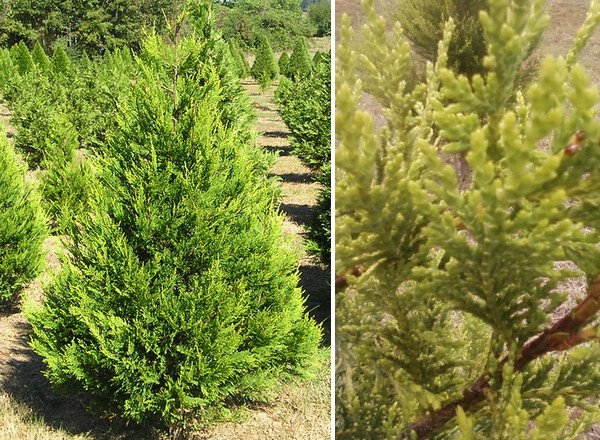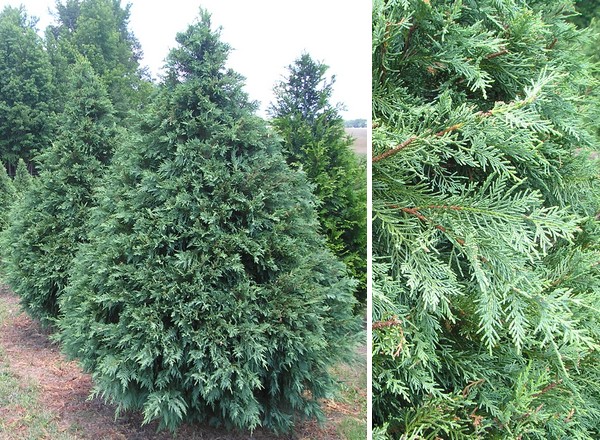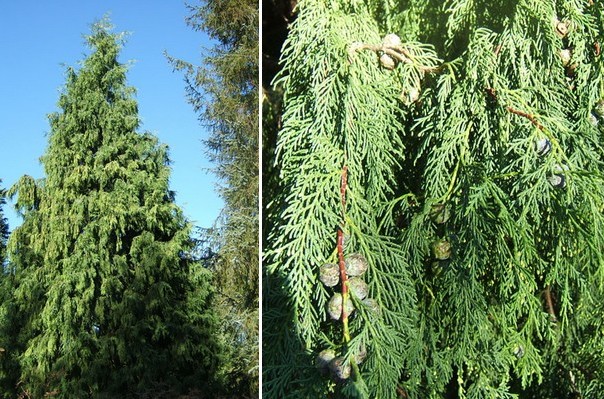|
We grow several varieties of Leyland Cypress. They are the Real Christmas Tree that will not drop needles. They have a natural pyramid shape with soft feathery branches. Check our News page to see which varieties and the size of the trees that are available this year.

Cupressus × leylandii 'Leighton Green' (Leyland Cypress)
This is the tree most people refer to as Leyland Cypress and is the cultivar most commonly used for Christmas trees. In landscape, they will grow to a height of over 30 feet.

Cupressus × ovensii (Ovens or Murray Cypress)
This tree is more open then Leighton Green with stronger branches and a darker green color. It also has more aroma.

Cupressus × leylandii 'Silver Dust' (Silver Dust)
This is a unique varietie of the Leyland Cypress. The foliage is splotched with patches of creamy white against the classic dark green of a regular Leighton Green Leyland Cypress.

Cupressus × leylandii 'castlewellan' (Castlewellan Gold)
The foliage of 'Castlewellan' is light green in summer, turning golden yellow in fall and winter. It poroduces round, brown female cones and ovoid, yellow male cones.

Cupressus × leylandii 'Naylor's Blue' (Naylor's Blue)
This tree has a bright, blue-gray foliage and the branches droop at the tips. The branches are stronger then Leighton Green,

Cupressus × notabilis 'notabilis' (Notabilis or Alice Holt Cypress)
This tree is called Alice Holt Cypress (after the Alice Holt Forest Research Station, where the hybrid was discovered). It has an open crown with drooping branch tips.
HISTORY of LEYLAND CYPRESS
These trees are the result of three different trees, cross pollinated with the Alaska-Cedar or Nootka Cypress, (Callitropsis nootkatensis ). The natural range of Alaska-cedar is from northern California to Prince William Sound, Alaska. The parent species would not likely cross in the wild as their natural ranges are more than 400 miles apart, but in 1888 the first Leyland hybrid cross occurred at Leighton Hall Estate in England. Female flowers or cones of Alaska-Cedar were fertilized by pollen from Monterey Cypress.
All Leyland Cypress are sterile, so the trees we see now, all resulted from cuttings originating from those original plants.
LEYLAND CYPRESS, Cupressus × leylandii
Alaska-Cedar crossed with the Monterey Cypress, (Cupressus macrocarpa), from southern California and is rated for Zone 6 cold hardiness. There are over 40 varieties of Cupressus × leylandii. The most popular is Leighton Green. Other varieties include, Haggerstown Grey, Stapehill, Castlewellan Gold, Douglas Gold, Drabb, Emerald Isle, Ferndown, Galway Gold, Golconda, Golden Sun, Gold Rider, Grecar, Green Spire, Grelive, Haggerston 3, Haggerston 4, Haggerston 5, Haggerston 6, Harlequin, Herculea, Hyde Hall, Jubilee, Medownia, Michellii, Moncal, Naylor's Blue, New Ornament, Olive's Green, Robinson's Gold, Rostrevor, Silver Dust, Variegata, Ventose Winter Sun and a tree recently patented in Florida, called Madeline.
NOTABILIS CYPRESS, Cupressus × notabilis, (also called Alice Holt Cypress)
Alaska-Cedar cross with a Smooth Arizona Cypress, (Cupressus arizonica var. glabra), at the Alice Holt Forest in Hampshire, England, 1956. Sinuous upswept branches draped with flattened sprays of grayish-green foliage.
OVENSII CYPRESS, Cupressus × ovensii, (also called Murray Cypress)
Crossed with a Mexican Cypress, (Cupressus lusitanica). 1961. More open than leylandii, and has stiffer branches. Also, has more aroma than leylandii. It has large flattened sprays of dark green foliage.
|